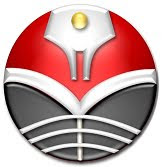Valuing Children's Literature by Bonar A Silalahi
Name : Bonar Argataman Silalahi
NIM : 0707816
Class : Non-Edu A2
Subject : Children’s and Adolescent Literature
Valuing Children’s Literature
Children's literature is a kind of literary works aimed for readers and listeners up to about age twelve. The term is used in senses which sometimes exclude young-adult fiction, comic books, or other genres. Books specifically for children existed by the 17th century.
1. Books written by children. A much-overlooked type of children's literature is work written by children, such as The Young Visiters by Daisy Ashford (aged 9).
2. Books written for children. Perhaps the most common definition of children's literature is those books intentionally written for children. Nancy Anderson, associate professor in the College of Education at the University of South Florida in Tampa, defines children's literature as all books written for children, "excluding works such as comic books, joke books, cartoon books, and nonfiction works that are not intended to be read from front to back, such as dictionaries, encyclopedias, and other reference material".
3. Books chosen for children. The most restrictive definition of children's literature are those books various authorities determine are "appropriate" for children, such as teachers, reviewers, scholars, parents, publishers, librarians, retailers, and the various book-award committees.
4. Books chosen by children. The broadest definition of children's literature applies to books that are actually selected and read by children. Children choose many books, such as comics, which some would not consider to be literature at all in the traditional sense; they also choose literary classics and recognized great works by modern writers, and often enjoy stories which speak on multiple levels. In the opinion of novelist Orson Scott Card, "one can make a good case for the idea that children are often the guardians of the truly great literature of the world, for in their love of story and unconcern for stylistic fads and literary tricks, children unerringly gravitate toward truth and power." In addition, many classic books that were originally intended for adults are now commonly thought of as works for children.
Types of children's literature
a. Children's literature by genres
A literary genre is a category of literary composition. Genres may be determined by technique, tone, content, or length. Nancy Anderson, associate professor in the College of Education at the University of South Florida in Tampa, has delineated six major categories of children's literature, with some significant subgenres:
- Picture books, including board books, concept books (teaching an alphabet or counting), pattern books, and wordless books
- Traditional literature: there are ten characteristics of traditional literature: (1) unknown authorship, (2) conventional introductions and conclusions, (3) vague settings, (4) stereotyped characters, (5) anthropomorphism, (6) cause and effect, (7) happy ending for the hero, (8) magic accepted as normal, (9) brief stories with simple and direct plots, and (10) repetition of action and verbal patterns. The bulk of traditional Literature consists of folktales, which conveys the legends, customs, superstitions, and beliefs of people in past times. This large genre can be further broken down into subgenres: myths, fables, ballads, folk music, legends, and fairy tales.
- Fiction, including the sub-genres of fantasy and realistic fiction (both contemporary and historical). This genre would also include the school story, a genre unique to children's literature in which the boarding school is a common setting.
- Non-fiction
- Biography, including autobiography
- Poetry and verse.
b. Children's literature by age category
Children's literature is an age category opposite adult literature, but it is sub-divided further due to the divergent interests of children age 0-18.
- Picture books appropriate for pre-readers ages 0–5. Caldecott Medal winners often (but not always) fall within this category.
- Early Reader Books appropriate for children age 5-7. These books are often designed to help a child build his or her reading skills.
- Chapter book appropriate for children ages 7–11.
- Short chapter books, appropriate for children ages 7–9.
- Longer chapter books, appropriate for children ages 9–12. Newbery Medal winners often (but not always) fall within this category.
- Young-adult fiction appropriate for children age 13-18
The criteria for these divisions are just as vague and problematic as the criteria for defining children's books as a whole. One obvious distinction is that books for younger children tend to contain illustrations, but picture books which feature art as an integral part of the overall work also crosses genres and age levels. Tibet: Through the Red Box by Peter Sis is a one example of a picture book aimed at an adult audience.
c. Series
Book series are not unique to children's literature. Series are also very popular in science fiction and crime fiction. Sometimes the success of a book for children prompts the author to continue the story in a sequel or to launch a series, such as L. Frank Baum's Wizard of Oz. Sometimes works are originally conceived as series, such as the Harry Potter books. Enid Blyton and R. L. Stine have specialized in open-ended series. Sometimes a series will outlive its author. When Baum died, his publisher hired Ruth Plumly Thompson to write more Oz books. The Nancy Drew series and others were written by several authors using the same pen name.









0 Response to "Valuing Children's Literature by Bonar A Silalahi"
Post a Comment